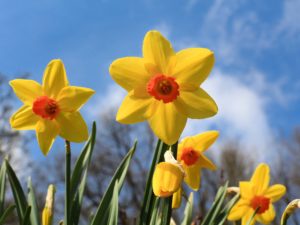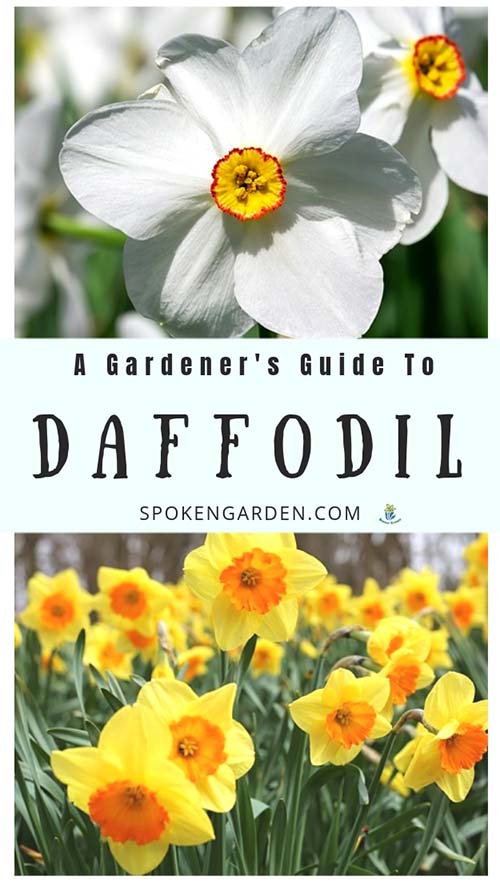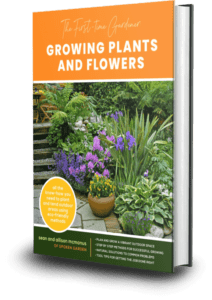The daffodils are coming!
As one of the first flowers to pop out of the ground, they signal the beginning of the spring season. And who wouldn’t be happy to see them?
Just thinking of these sunny, cheerful flowers evokes a sense of warmth and happiness. They are easy to grow, multiply quickly, and return year after year.
Quick Plant Care Facts
| Sun Exposure | Full sun while blooming and partial shade afterwards. |
| Water Needs | Regular watering when they are growing and during bloom. |
| Soil Needs | Will grow in a range of soils, but prefer well draining, slightly nutrient rich soil. |
| Cold-Hardiness Zones | USDA hardiness zones 3 to 9. |
| Bloom Time | Late Winter into mid Spring. |
| Flower Colors | Basically yellow and white with many variations on this with orange, red, apricot, pink, and cream. |
| Mature Height/Width | Generally anywhere from 6" to 18" in height and at least 6" to 8" wide. |
| Plant Spacing | Single or in groups, they will need 6" to 8" apart. |
Before you continue, are you starting to think about summer-flowering bulbs? If so, look no further than our ebook 21 Spring-Planted Bulbs For Fantastic Summer Color, which is brand new for 2021.
With 60+ pages of summer flowering bulb inspiration, you can get to know the different plant care needs of these 21 gorgeous spring-planted, summer-flowering bulbs. Whether you are already familiar with bulbs or are just learning about them, this guide explains what bulbs are, defines the 5 different types of bulbs, the correct planting orientation for each of the 5, and much more.
In 21 spring-planted, summer-flowering bulbs, you’ll also learn where they will grow, when they flower, different flower colors available, and which online retailers sell them. Grab your copy now and start planning your spring and summer flower garden TODAY!
Daffodils: Why We’re Featuring This Plant
First, they are symbolically important around the world.
In addition to their beauty, daffodils often symbolize rebirth and renewal due to their early spring arrival. Did you know they are considered the flower of the month for March?
They can also symbolize friendship.
In addition, they are really easy to grow and have low maintenance requirements.
Whether growing naturally in the wild or grown commercially, the daffodil emerges from a true bulb into the beautiful varieties we see today.
So, where are daffodils native? How many different varieties or colors are available?
Read on to learn about the common characteristics of this flower and even a few fun facts about this plant known around the world.
Daffodil Flowers: History and Symbolism
Daffodil Family
Daffodils, also known as jonquils or narcissus, are in the Amaryllidaceae family. Also known as the Amaryllis family, this group of herbaceous perennials includes many ornamental garden plants and also vegetables.
Other members of this important family include Snowdrops, amaryllis, chives, leeks, onions, and garlic.
Daffodil Symbolism and History
Many people have long since cherished the daffodil for its cheerful presence, but our history focuses on Greek mythology and the tale of Narcissus.
Read on to find out what the daffodil and Greek mythology have in common.
From its humble beginnings, the daffodil can be traced back to early Greek civilization and attributed to a tale involving Greek Gods, Narcissus, Echo, and Nemesis.
In brief, the myth states that Narcissus, granted divine handsomeness and immortality by the Gods, would keep his divine gifts as long as he never viewed his own reflection. Upon rejecting a wood nymph’s advances (Echo), he was later lured to his fate by Nemesis who tricked him into viewing his reflection.
Narcissus fell in love with himself and thus withered away forever as divine punishment from the Gods.
The myth states that he was replaced by a beautiful flower, the Narcissus.
The Greeks and Romans later used the daffodil and its flowers, stems, and bulbs for the so-called healing powers that 
Ironically, the flowers and bulbs are poisonous to ingest and the sap is irritating to the skin.
A beautiful flower with a deadly ending, just like Narcissus.
In addition to the Greek tales, daffodils are also known as the official flower of Wales. The arrival of daffodils in early Spring coincides with a Welsh holiday on March 1st.
Daffodil Festival
There is a Puyallup Daffodil festival in Washington State (close to our hometown) that celebrates the arrival of spring season and the agriculture industry in the area.
Originally started in 1934, daffodils are used to adorn and decorate for the big Daffodil parade.
Check out the link above to learn more!
Hey, have you listened to our podcast yet? Check it out!
Daffodil Bulbs
Daffodil bulbs are really easy to plant and then require very little maintenance after that.
The first rule to remember, Daffodils should be planted only in the fall or winter and only if they can tolerate your winter climate and soil moisture.
After you get them in the ground, they will multiply and come back every Spring season for years to come!
Steps for Planting Daffodil Bulbs
Here are a few quick tips for properly planting your Daffodil bulbs in the Fall:
1.Plant each bulb in the correct orientation.
- There is a definite top and bottom to each bulb.
- Look for the pointy tipped top which should be pointed up.
- The flatter end with the roots on the bottom.
- If you aren’t sure, plant the bulb on its side so it can still grow and flower in your garden.
2. Plant each Daffodil at a depth of 2 to 3 times larger than the bulb’s height.
- Use a Bulb Auger to dig holes fast!
3. Space each Daffodil about twice the bulb’s width.
- Keep in mind there will be some size variation between the bulbs so this is not an exact number.
4. Don’t plant them too deep.
- Make sure to include any mulch on top of your soil as part of the soil-planting depth.
- If you bury them too deep you could risk not seeing them next spring.
- Using the right tools can help lessen the chance of planting them too deep.
5. Plant your Daffodil bulbs 6-8 weeks before the ground freezes (it’s ok if the night temps are in the 40’s or 50’s).
- This is a general rule for most Spring flowering bulbs.
- It is ok if you are a little early or late on this 6-8 week range.
What do you do with Daffodils after they bloom?
Once your daffodils are done blooming, they require a bit of aftercare. It’s quite easy and simple to care for these and other spring-flowering bulbs after they are done flowering for the season or year: Simply leave them alone and let them continue to have green leaves.
You can remove the old, withered flower by cutting below it on the stem just above the closest leaf and compost the flower. Leave the leaves until they have also withered and are brown down to the ground. Once they are brown to the ground, then you can either cut or tear away the leaves and stem at the ground level. Make sure not to remove or pull up the actual Daffodil bulb.
Waiting for the leaves and stem to turn brown and wither to the ground lets the Daffodil complete its natural and biological cycle for the year. One benefit of letting each bulb wither down to the ground after blooming is to produce smaller versions of itself underneath the ground to multiply in your garden. Another benefit letting stem and leaves wither naturally lets each bulb pull down any water and nutrients from above ground back into the bulb for its survival and continuation in your garden.
So, leave the green until it’s brown and withered. Then remove the leaves and stem. Your daffodils and other spring-flowering bulbs will thank you.
Daffodil Bulbs For Sale
The best part is there are so many different varieties to choose from with various color combinations, heights, and sizes of flowers.
Two companies we recommend for purchasing your daffodil bulbs are Eden Brothers and Brent and Becky’s.
Conclusion
As you can see, this flower has a long history from its humble beginnings to the mass commercial empire in bulb production it has become today.
Once a simple wildflower, the Daffodil has been cultivated and bred with huge success throughout the years.
Make sure to stop and take notice of the beautiful daffodils in your garden, your local parks, or anywhere else these sunny perennials have decided to pop up and grace us with their beauty.
We like to think of how this flower has inspired poets, scholars, countries, and parade organizers throughout the years with its grace and cheerful disposition.
Daffodil Poem
I wandered lonely as a cloud
That floats on high o’er vales and hills,
When all at once I saw a crowd,
A host, of golden daffodils;
Beside the lake, beneath the trees,
Fluttering and dancing in the breeze
~ William Wordsworth
Well, that’s all for now.
Thanks for reading and we hope we inspired you or educated you in some way with our Daffodil plant profile.
Want to learn about other plants in your garden? Check out some of our other plant profiles:
- The Gardener’s Guide to Dianthus
- The Gardener’s Guide to Chrysanthemums
- Hello Hellebore! January Plant Profile
- A Rose By Any Other Name: February Plant Profile
- Clover: A Gardener’s Guide and Plant Profile
If you aren’t sure where to start learning about gardening, go to our Start Here page where you can get find beginning gardener topics by listening, watching, and reading.
See you in the garden!
~ Sean and Allison
P.S. Find us on YouTube, Pinterest, Twitter, Facebook, and Instagram so you don’t miss a thing!

Click the graphic above to save “Daffodil Gardener’s Guide and Plant Profile” to Pinterest for later!



